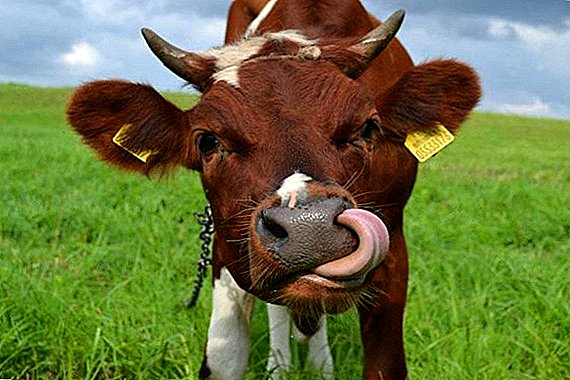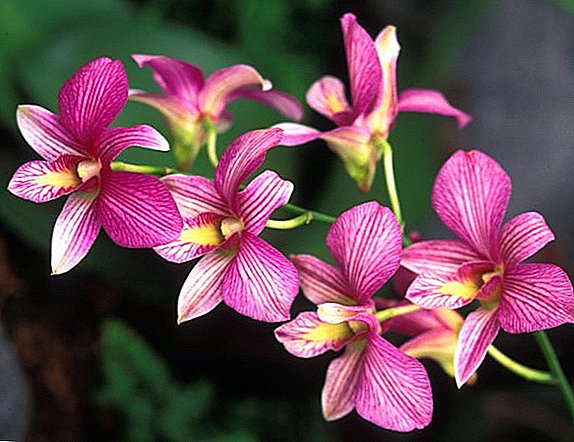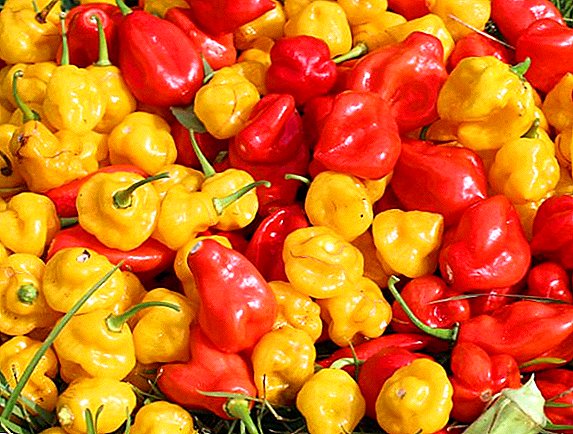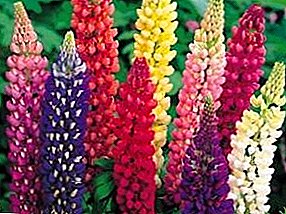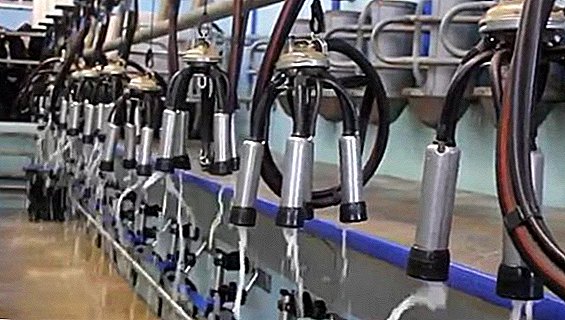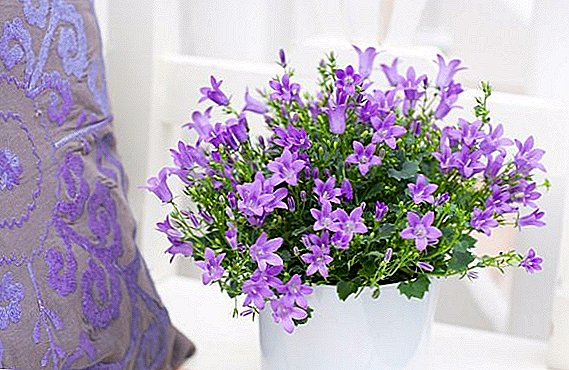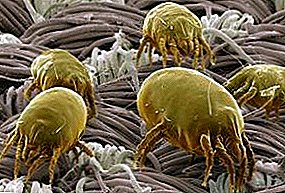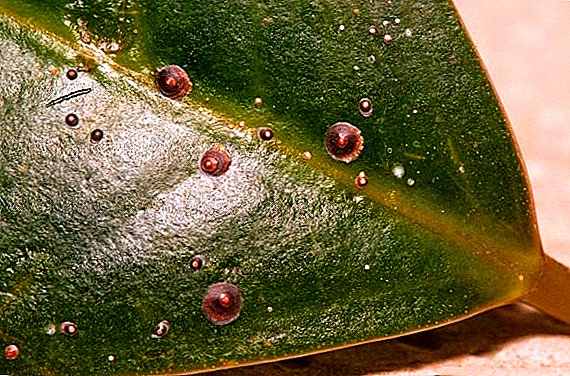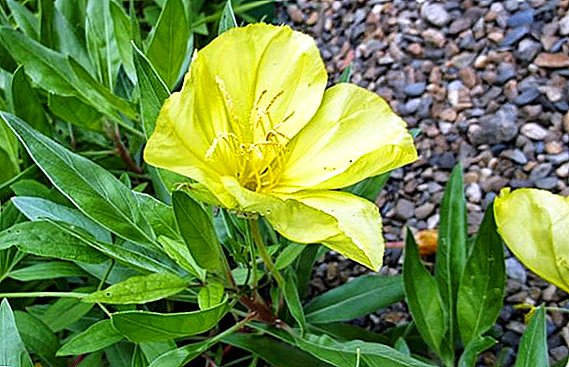 Often, among a large variety of plants in a flower bed or in the garden, unusual flowers can be seen, distinguished by the originality of their appearance. Lunaria - the romantic name of these plants, for the name of which in any of the languages of the world is taken as the basis the word "moon". It is believed that when the moon, these flowers begin to bloom. There is also a version that its name Lunar (lunik, lunar grass) received for the extraordinary resemblance of fruits with the shape of a full moon. Whatever it was, and this plant is really distinguished by uncommonness and is able to decorate any flower garden, without remaining unnoticed.
Often, among a large variety of plants in a flower bed or in the garden, unusual flowers can be seen, distinguished by the originality of their appearance. Lunaria - the romantic name of these plants, for the name of which in any of the languages of the world is taken as the basis the word "moon". It is believed that when the moon, these flowers begin to bloom. There is also a version that its name Lunar (lunik, lunar grass) received for the extraordinary resemblance of fruits with the shape of a full moon. Whatever it was, and this plant is really distinguished by uncommonness and is able to decorate any flower garden, without remaining unnoticed.
Description
Lunar belongs to the genus of annual and perennial plants. Can grow up to a meter. Flowers Lunar bright, their palette is quite diverse. The plant begins to bloom in mid-May, has a fragrant smell that especially attracts bees. 
The plant produces fruits, the seeds of which are used for the purpose of reproduction. When describing a lunarium, it is necessary to take into account its species.
Moon species
Two species of this herbaceous plant are known: one-year-old (L. annua) and perennial (L. rediviva), or a reviving lunik.
Lunar one year
Lunaria annual - plant from 30 cm to a meter tall. Its stem is characterized by the presence of branches. The leaves of the plant, located on the petioles, are heart-shaped. The lunar annual blooms from May to June, giving white, pink or purple flowers.
Annuals are also such flowers as asters, cockles, lobularia, dahlias, pentas, iberis, coleus, lobelia, brachycomus.
Shades of color when flowering can be from light to darker. Most varieties of annual Lunaria bloom are distinguished by a fragrant unforgettable scent. 
After flowering ends, approximately in August, sufficiently large, flat, rounded shapes appear, with translucent walls and a septum, which persist for quite a long time. Their size - up to 4 cm, and the color resembles silver.
Did you know? People with a greater degree of pragmatism, noticed in the lunar fruit similarity with the coins, so they called the plant a silver ruble, silversmith.
Although lunik is considered an annual plant, in fact it is two years old. During the first year after germination, it gives only a rosette of leaves, and the plant begins to actively bloom in the second year. After the end of flowering, the lunar activity also ends.
When grown at home, Lunaria annual can quite please with its amazing flowering in the first year of life and become a truly annual plant. 
Lunar reviving (or perennial)
Perennial lunaria mainly grows in deciduous and coniferous forests, shrubs, near water bodies. The plant reaches a height of one meter. If you pay attention to its leaves, you can see that the lower petioles are represented in the form of inverted hearts, and the upper ones are oval, as if sedentary.
Strong plants are capable of flowering in the first year of life, but the main flowering process occurs in the second year of life. The plant begins to bloom at the end of spring and continues this process for another month.
Perennial flowers such as petunia terry, heliopsis, lupine, gelenium, nemesia, garden balsam, osteospermum.
Lunaria flowers have a size of up to 4 cm and are four-leaf purple inflorescences located between the upper and lower layers of leaves, as well as at the very top of the branched part of the stem.
The plant during flowering pleasantly smells sweet. After the end of flowering in the second half of the summer and until the beginning of autumn, the fruits of Lunaria appear in the form of large pointed pods. 
Important! Lunaria reviving was known during the Middle Ages for its healing abilities. In folk medicine, it is used to get rid of nervous disorders, spasmodic processes in the gastrointestinal tract, dropsy and edema.
Growing up
Lunar, both annual and perennial, is grown in gardens, parks, flower beds, for gardening private plots.
Seedling
Planting seedlings is suitable only for the perennial lunar species. For seedlings, seeds are sown in a greenhouse or greenhouse in March. Before sowing, mature seeds are selected with a dark brown shade up to 6 mm in size. From the end of May, seedlings are planted in open soil. 
Location
Seedlings are planted in open ground at a distance of 30-40 cm from each other. But since the seeds of a lunaria are characterized by an almost absolute ability to germinate, therefore they can also be sown immediately to a permanent place up to 40 cm from each other to a depth of 3 cm.
For one hundred percent germination of seeds, they need to be sown correctly in a suitable place with fertile soil.
The main distinctive feature between the lunar perennial and annual is their different attitude to the sunlight. An annual lunnik without the rays of the sun will not be able to grow and develop normally, while the perennial one in the sunlight begins to wither, dry, turn yellow, turns pale and shallows.
Therefore, optimally sunny and open spaces are suitable for the annual Lunaria, the reviving Lunaria feels better in the shade. To both of them, to some extent, partial shade may be appropriate. Such an important nuance, such as lightness, must be taken into account when landing a lunaria. 
Important! Perennial lunaria is capable of growing for many years in one place with suitable conditions. It can not be transplanted from place to place.
The soil
The annual lunik does not manifest any special requirements for the nutritional value of the soil, it is absolutely not capricious, but it still feels better, grows, blooms, develops on fertile soils. Therefore, the composition of the depleted soil needs to be done better with the help of peat, compost, add standard mineral fertilizers.
The mineral fertilizers include such plants as Kemira, Azofoska, Plantafol, Kristalon, Sudarushka, and Ammophos.
Lunaria revived is more demanding on the composition and nutritional value of the soil; it will feel well in sufficiently moist and fertilized with humus soil. Soil for planting and growing a lunar perennial should be different friability, sufficient aeration, full of nutrients.
For the full development of this type of lunar the land before planting should be well loosened, having dug to a depth of at least 20 cm with the addition of humus (4 kg per square meter). It does not hurt to make a little lime. 
Care
Lunaria unpretentious in terms of care. The annual view of this plant can grow in all conditions. A perennial lunik can grow for a long time in one place without a transplant, which is extremely undesirable for it.
But if he is provided with a good soil in a shady place, then he will not have to feel any special cares to take care of him.
Watering
After planting seed beds must be watered. This will contribute to the fact that sprouts seem in a few days. Lunar annual is watered only during dry periods. Perennial Lunaria likes abundant watering, but do not do it too often, just a couple of times a week.
If it is dry summer weather, then you need to water more often. The lack of moisture, the lunnik, which comes to life, does not tolerate as firmly as its excess. But we must also remember that the stagnation of moisture can lead to rotting of the root system. After the end of the ripening of fruits on the plant, it is necessary to stop watering. 
Important! Due to the constant deforestation of forests, the number of Lunarians has significantly decreased, therefore the plant is listed in the Red Book.
Top dressing
Top dressing in the form of fertilizers is brought in the soil as soon as the vegetative period begins to the middle of summer. It occurs twice a month. For this, various mineral fertilizers containing phosphorus and potassium, ammonium sulfate are used.
As a feed you can use organic fertilizer, humus. It is best to dilute the fertilizer in water and water the resulting solution of the plant at the root.
Winter hardiness
Lunaria annual is a winter-hardy plant that does not need special shelter for the winter period and is able to withstand the most severe winter frosts under the snow. 
Long-term Lunaria does not have such absolute winter hardiness, it is especially afraid of late frosts, and therefore needs additional shelter during the winter season.
Breeding methods
Lunaria one-year mainly reproduces by seed. Among them, you need to pre-select the most mature specimens with dark brown staining up to 5-6 mm. They are planted in a permanent place at a distance of 30-40 cm from each other from late spring to mid-summer.
After seven days, the first shoots should appear. If necessary, seedlings can be transplanted to a new place in August.
If there is a need to propagate the lunar, without waiting for the appearance of fruits with seeds, then you can cut several shoots, lower them into the water, wait for the roots to form, and then plant them in open soil. 
Breeding of a lunnik is reviving is also possible with the help of seeds. But it is recommended to sow them in the winter at a distance of up to 40 cm and to a depth of 5 cm, shoots should appear in spring, approximately in May.
Seedlings crown, by the end of the growing season, a couple of leaves appear on them, and the roots reach sizes up to 10 cm, the second pair of leaves will appear only at the end of summer. The flowering of the main perennial lunik begins only in the second year in May and blooms until July.
Perennial lunar can be propagated in a vegetative way using the separation of the roots. A fragment of the root is separated and planted in a specially prepared place, watered.
Important! In good conditions, a perennial lunar can multiply by self-seeding.

Diseases and pests
Lunar both annual and perennial are fairly resistant to the appearance of pests and diseases. But from time to time they may fall prey to the attack of aphids, listobloshki, cabbage butterfly, cruciferous flea.
All pests are successfully excreted with insecticidal agents. Fungal diseases affect Lunaria very rarely, but in case of detection of such a problem, fungicides can help.
To insecticides include drugs such as "Fastak", "Calypso", "Alatar", "BI-58", "Angio", and to fungicides - copper sulfate, "Signum", "Prozaro", "Alto Super", " Kuproksat, Allett, Bravo.
Use in landscape design
Fruiting Lunaria is an extraordinary decorative value, sometimes just for the sake of being able to see the fruits of this amazing plant, the growers are engaged in growing moonfish. The plant found its place in landscape design, having earned attention due to its unusual external beauty and unpretentiousness.
In the group, the Lunarium looks irresistible, but it must be borne in mind that flowers should grow at a distance of at least 30 cm, otherwise they will have an unattractive appearance, they will become pale with a small amount of flowers, and the look of such a planting itself will not make admire. 
Harmoniously Lunar can look on the Moorish lawn, which does not mow, so the plant will look attractive among other herbs. A moonflower looks great in a flowerbed or in a garden among poured decorative gravel, where close neighbors can be wormwood, barley, thyme, asters, tansy, and feather grass.
Such planting will practically not cause hassle to remove weeds, they are simply absent there. Well suited for planting lanari on flowerbeds cottages, which the owners visit infrequently, because it does not require constant care.
Perennial lunaria - just a godsend to decorate the shaded places on the plot. And the cut and dried branches of the moon with fruits will become a real decoration of a cozy home in the middle of cold winter.
Did you know? Surprisingly, Lunar belongs to the Cruciferous family, moreover, as cabbage.

The mystery of the beauty of the lunar cannot leave anyone indifferent to anyone who has ever seen this plant flourishing and fruitful.
Only two types of lunar are able to decorate with themselves both sunny household plots, and mostly staying in the shade, but also requiring a bit of beauty for themselves, because not every plant is able to withstand the lack of access to sunlight.
And in the winter, the dried up branches with the fruits of this amazing plant will decorate themselves and add a little elegance to any home.


